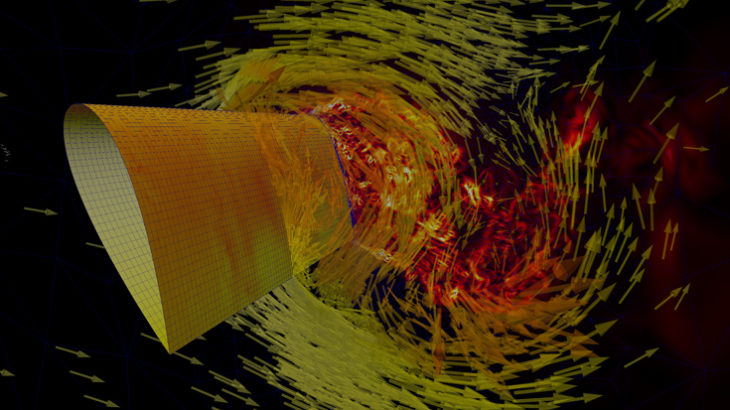Solving unsteady fluid flows with Hyperflux

An Innovate UK- and EPSRC-funded project called Hyperflux is bringing together industry and academia to tackle the problem of modeling unsteady fluid flow. Peter Vincent, Senior Lecturer and EPSRC Fellow in the department of Aeronautics at Imperial College London, heads up the academic side of this project. His team is working with engineers at CFD company Zenotech and CFMS, an independent centre for modelling and simulation based at the Bristol & Bath Science Park, to create a commercial product called Hyperflux, which will help industry to model these unsteady flows. As of early 2015, the team has already managed the development and rolling release of PyFR (www.pyfr.org) as well as the identification of new symmetric quadrature rules.
Working with Emerald
The Imperial College team has been working on Emerald for sometime, funded by EPSRC, to develop an open source CFD solver called PyFR. Hyperflux will be a commercial variant of this, embedded in Zenotech’s cloud-based, GPU-accelerated high performance CFD solver called zCFD. Emerald has been invaluable in developing PyFR;
The two-year project, funded through Innovate UK and the EPSRC, now has a number of industry partners associated with it who will be the first users and testers. Vincent says “we hope this project will have a real impact on industry; allowing CFD practitioners to undertake simulations that have hitherto been intractable”.
Iso-surfaces of density behind a NACA0021 aerofoil in ‘deep stall’, obtained using PyFR.
Iso-surfaces of density in the vicinity of an idealised ‘deployed spoiler’ obtained using PyFR.
Velocity field vectors behind a NACA0021 aerofoil in ‘deep stall’, obtained using PyFR
Utilising GPUs
The numerical methods being developed by Vincent and his team are called Flux Reconstruction schemes. They have “very nice mathematical properties, one of which is that they offer an efficient route to getting very high degrees of accuracy in your simulation, which you need in these unsteady flows. But moreover, the way these algorithms are designed is very well suited for implementation on modern hardware platforms like GPUs, to get as many FLOPs out of the hardware as possible.”
“We’re getting more and more results in all the time that indicate we’re on the right lines. We’re comparing industry-standard tools with PyFR on unsteady problems and we’re getting orders of magnitude increases in performance and accuracy with PyFR. So it’s all very promising – though I wouldn’t say we’ll have solved it until the Hyperflux project is complete, and the technology is passed on to industry to use”
Dr. Peter Vincent, Imperial College London
Vincent notes three key points in working with GPUs:
- It’s important to design algorithms in the context of the hardware’s capabilities, to get the most out of it
- If software is well designed, users can see a speed up factor of up to five times for a per-dollar spend on GPUs over CPUs.
- GPUs represent where all of modern hardware is heading. Computer devices are going to be characterised by an abundance of floating-point operations relative to memory bandwidth, all of these FLOPs being offered up in an extraordinarily parallel fashion.
Moving Forward
Zenotech’s engineers are now working to embed technology from PyFR into their ‘industry-ready’ cloud-based platform called zCFD. Vincent says he enjoys working with the Zenotech and CFMS teams – being small organisations, they’re dynamic and the relationship is very positive. “Zenotech is very au fait with GPUs – their existing CFD products use them, and so Hyperflux will as well. The reality is that that’s where hardware is going to go. And unless you’re developing your software, and your numerical methods, to be able to work on that effectively, you won’t get any sort of performance out of the hardware.”
“As well as running on small workstations we need to know PyFR can run on large CPU clusters, so without Emerald to test it on, we couldn’t have done what we’ve done”
Dr. Peter Vincent, Imperial College London
The Hyperflux project, which began in September 2014, is due to run for two years, and Vincent has funding for a further two years to work on unsteady flow modelling software.
- Witherden, F.D., Farrington, A.M., Vincent, P.E., PyFR: An open source framework for solving advection–diffusion type problems on streaming architectures using the flux reconstruction approach – Computer Physics Communications, November 2014, Volume 185, Issue 11, Pages 3028–3040Publications:
- Witherden, F.D., Vincent, P.E., An Analysis of Solution Point Coordinates for Flux Reconstruction Schemes on Triangular Elements – Journal of Scientific Computing, November 2014, Volume 61, Issue 2, pp 398-423,
- Jameson, A., Vincent, P.E., Castonguay, P., On the Non-linear Stability of Flux Reconstruction Schemes – Journal of Scientific Computing, February 2012, Volume 50, Issue 2, pp 434-445
- Vincent, P.E., Castonguay, P., Jameson, A., A New Class of High-Order Energy Stable Flux Reconstruction Schemes – Journal of Scientific Computing, April 2011, Volume 47, Issue 1, pp 50-72
- Vincent, P.E., Castonguay, P., Jameson, A., Insights from von Neumann analysis of high-order flux reconstruction schemes – Journal of Computational Physics, 10 September 2011, Volume 230, Issue 22, Pages 8134–8154
- Witherden, F. D., Vincent, P. E., On the Identification of Symmetric Quadrature Rules for Finite Element Methods – Computers and Mathematics with Applications, Volume 69, Issue 10, Pages 1232-1241, 2015
Contact

Dr Peter Vincent
Senior Lecturer and EPSRC Early Career Fellow, Department of Aeronautics Imperial College London

